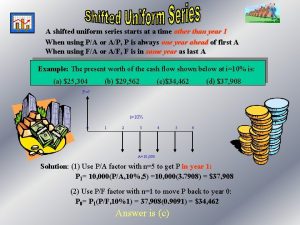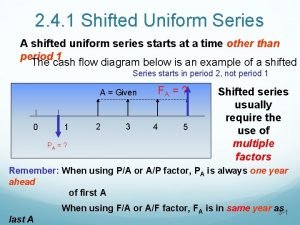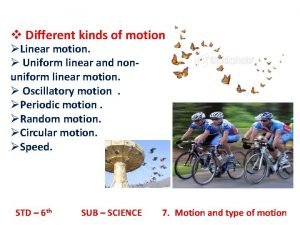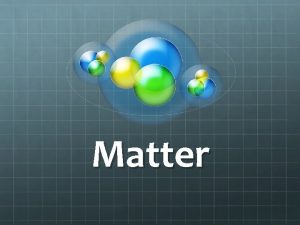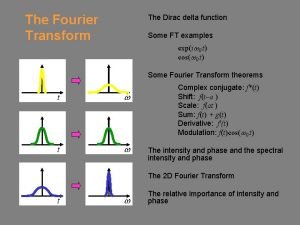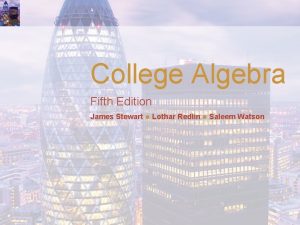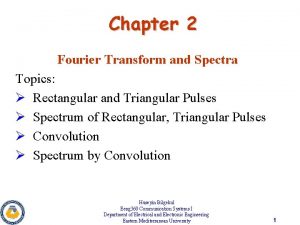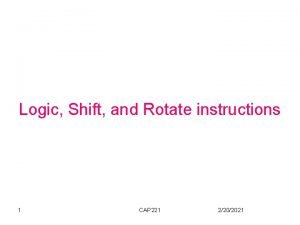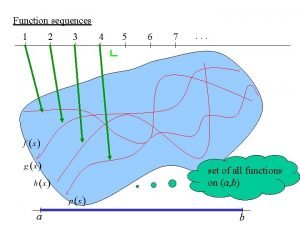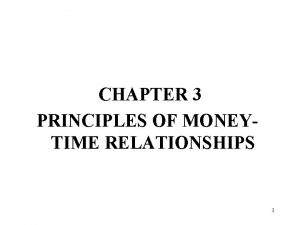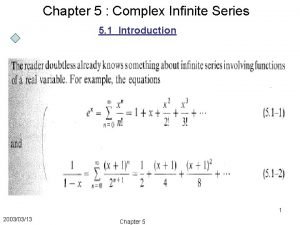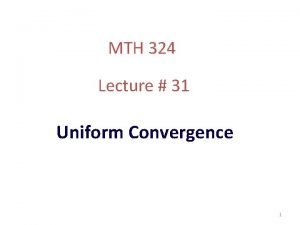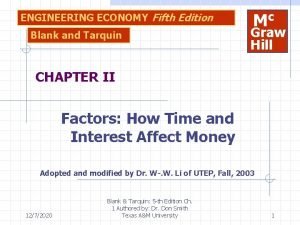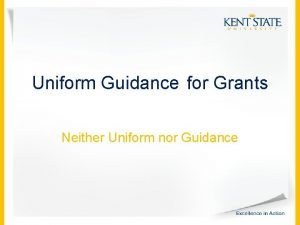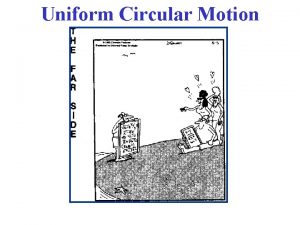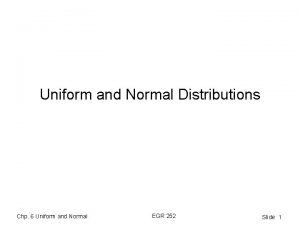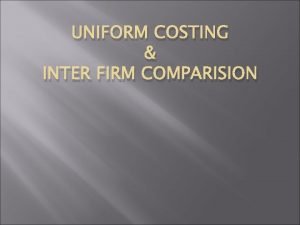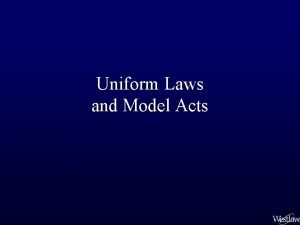2 4 1 Shifted Uniform Series A shifted



















- Slides: 19

2. 4. 1 Shifted Uniform Series A shifted uniform series starts at a time other than period 1 The cash flow diagram below is an example of a shifted Series starts in period 2, not period 1 A = Given 0 1 PA = ? 2 3 FA = ? 4 5 Shifted series usually require the use of multiple factors Remember: When using P/A or A/P factor, PA is always one year ahead of first A last A When using F/A or A/F factor, FA is in same year as 3 -1

Series The present worth of the cash flow shown below at i = 10% is: P 0 = ? P 1 = ? 0 1 0 5 Solution: in year 1 i = 10% 2 3 1 2 4 3 5 4 Actual year Series 6 year A = $10, 000 (1) Use P/A factor with n = 5 (for 5 arrows) to get P 1 (2) Use P/F factor with n = 1 to move P 1 back for P 0 in yea P 0 = P 1(P/F, 10%, 1) = A(P/A, 10%, 5)(P/F, 10%, 1) = 10, 000(3. 7908)(0. 9091) = $34, 462 3 -2

2. 4. 2 Shifted Series and Random Single Amounts For cash flows that include uniform series and randomly placed single amounts: Uniform series procedures are applied to the series amounts Single amount formulas are applied to the one-time cash flows The resulting values are then combined per the problem statement The following slides illustrate the procedure 3 -3

Example: Series and Random Single Amounts Find the present worth in year 0 for the cash flows shown using an interest rate of 10% per year. PT = ? 0 9 i = 10% 1 10 2 3 4 5 6 A = $5000 PT = ? 0 9 7 8 $2000 i = 10% 1 10 2 0 3 1 4 2 5 3 A = $5000 6 4 7 5 $2000 8 6 Actual 7 year 8 Series year Solution: First, re-number cash flow diagram to get n for uniform series: n 3 -4

Example: Series and Random Single Amounts P A PT = ? i = 10% 0 9 1 10 2 0 3 1 4 2 5 3 A = $5000 6 4 7 5 $2000 8 6 Actual year 7 8 Series year Use P/A to get PA in year 2: PA = 5000(P/A, 10%, 8) = 5000(5. 3349) = $ Move PA back to year 0 using P/F: P 0 = 26, 675(P/F, 10%, 2) = 26, 675(0. 82 Move $2000 single amount back to year 0: P 2000 = 2000(P/F, 10%, 8) = 2000(0. 4 Now, add P 0 and P 2000 to get PT: PT = 22, 044 + 933 = $22, 977 1 -5

Example Worked a Different Way (Using F/A instead of P/A for uniform series) The same re-numbered diagram from the previous slide is used PT = ? FA = ? i = 10% 0 9 1 10 2 0 3 1 4 2 5 3 A = $5000 6 4 7 5 8 6 7 8 $2000 Solution: Use F/A to get FA in actual year 10: FA = 5000(F/A, 10%, 8) = 5000(11. 4359) = $57, 180 Move FA back to year 0 using P/F: P 0 = 57, 180(P/F, 10%, 10) = 57, 180(0. 3855) = $22, 04 Move $2000 single amount back to year 0: P 2000 = 2000(P/F, 10%, 8) = 2000(0. 4665) = $ Same as before Now, add two P values to get PT: PT = 22, 043 + 933 = $22, 976 As shown, there are usually multiple ways to work equivalency problem 3 -6

2. 4. 3 Shifted Arithmetic Gradients Shifted gradient begins at a time other than between periods 1 and 2 Present worth PG is located 2 periods before gradient starts Must use multiple factors to find PT in actual year 0 To find equivalent A series, find PT at actual time 0 and apply (A/P, i, n) 3 -7

Example: Shifted Arithmetic Gradient John Deere expects the cost of a tractor part to increase by $5 per year beginning 4 years from now. If the cost in years 1 -3 is $60, determine the present worth in year 0 of the cost through year 10 at an interest rate of 12% per year. i = 12% PT = ? Actual years 0 1 2 0 60 60 3 4 1 60 10 5 2 65 3 Gradient years 70 95 G=5 Solution: 8 First find P 2 for G = $5 and base amount ($60) in actual year 2 P 2 = 60(P/A, 12%, 8) + 5(P/G, 12%, 8) = $370. 41 P 0 = P 2(P/F, 12%, 2) = $295. 29 Next, move P 2 back to year 0 Next, find PA for the $60 amounts of years 1 and 2 PA = 60(P/A, 12%, 2) = $101. 41 Finally, add P 0 and PA to get PT in year 0 3 -8 PT = P 0 + PA = $396. 70

PT = ? i = 12% 1 0 3 2 0 0 1 60 1 2 60 4 2 Actual years 10 5 3 8 ? Gradient years Series years 60 65 70 95 3 -9

2. 4. 4 Shifted Geometric Gradients Shifted gradient begins at a time other than between periods 1 and 2 Equation yields Pg for all cash flows (base amount A 1 is included) Equation (i ≠ g): Pg = A 1{1 - [(1+g)/(1+i)]n/(ig)} For negative gradient, change signs on both g values There are no tables for geometric gradient factors 3 -10

Example: Shifted Geometric Gradient Weirton Steel signed a 5 -year contract to purchase water treatment chemicals from a local distributor for $7000 per year. When the contract ends, the cost of the chemicals is expected to increase by 12% per year for the next 8 years. If an initial investment in storage tanks is $35, 000, determine the equivalent present worth in year 0 of all of the cash flows at i = 15% per year.

Gradient starts between actual years 5 and 6; these are gradient years 1 and 2. Pg. P is= 7000{1 -[(1+0. 12)/(1+0. 15)] located in gradient year 0, which is actual year 4 9/(0. 15 -0. 12)} = $49, 401 g Move Pg and other cash flows to year 0 to calculate P Next, find PA for the $7000 amounts of years 1 and 4 Next, find P 0 for at year 0 , PT = 35, 000 + 7000(P/A, 15%, 4) + 49, 401(P/F, 15%, 4) = $83, 232 1 -12

Negative Shifted Gradients For negative arithmetic gradients, change sign on G term from + General equation for determining P: P = present worth of base amou Changed from + to - For negative geometric gradients, change signs on both g valu Changed from + to - Pg = A 1{1 -[(1 -g)/(1+i)]n/(i+g)} Changed from - to + All other procedures are the same as for positive gradients 3 -13

Example: Negative Shifted Arithmetic Gradient For the cash flows shown, find the future worth in year 7 at i = 10% PT = ? PG = ? 0 1 0 6 i = 10% 2 1 700 FG = ? , FT = ? 3 4 2 650 3 600 5 4 550 500 6 5 Actual years 7 Gradient years 450 G = $-50 Solution: Gradient G first occurs between actual years 2 and 3; these are gradient years 1 an PG is located in gradient year 0 (actual year 1); base amount of $700 is in gradient PG = 700(P/A, 10%, 6) – 50(P/G, 10%, 6) = 700(4. 3553) – 50(9. 6842) = $2565 FG = PG(F/P, 10%, 6) = 2565(1. 7716) = $4544 PT =PG (P/F, 10%, 1) FT =PT (F/P, 10%, 7) 3 -14

2. 5 Factor Values for Untabulated i or n 3 ways to find factor values for untabulated i or n values Use formula Use spreadsheet function with corresponding P, F, or A valu Linearly interpolate in interest tables Formula or spreadsheet function is fast and accurate Interpolation is only approximate 2 -15

Example: Untabulated i Determine the value for (F/P, 8. 3%, 10) Formula: F = (1 + 0. 083)10 = 2. 2197 OK Spreadsheet: = FV(8. 3%, 10, , 1) = 2. 2197 OK Interpolation: 8% ------ 2. 1589 8. 3% -----x 9% ------ 2. 3674 x = 2. 1589 + [(8. 3 - 8. 0)/(9. 0 - 8. 0)][2. 3674 – 2. 1589] = 2. 2215 Absolute Error = 2. 2215 – 2. 2197 = 0. 0018 , 0. 08 % 2 -16

Unknown Recovery Period n Unknown recovery period problems involve solving for n, given i and 2 other values (P, F, or A) (Like interest rate problems, they usually require a trial & error solution or interpolation in interest tables) Procedure: Set up equation with all symbols involved and solve fo A contractor purchased equipment for $60, 000 that provided income of $8, 0 per year. At an interest rate of 10% per year, the length of time required to r the investment was closest to: (a) 10 years Solution: (b) 12 years (c) 15 years (d) 18 years Can use either the P/A or A/P factor. Using A/P: 60, 000(A/P, 10%, n) = 8, 000 (A/P, 10%, n) = 0. 13333 From A/P column in i = 10% interest tables, n is between 14 and 15 Answer years is (c) 2 -17

Unknown Interest Rate i Unknown interest rate problems involve solving for i, given antrial and other values (P, F, orin. A ) (Usually requires and 2 error solution or interpolation interest tables) Procedure: Set up equation with all symbols involved and solve fo A contractor purchased equipment for $60, 000 which provided income of $16, 000 per year for 10 years. The annual rate of return of the investment was closest to: (a) 15% Solution: (b) 18% (c) 20% (d) 23% Can use either the P/A or A/P factor. Using A/P: 60, 000(A/P, i%, 10) = 16, 000 (A/P, i%, 10) = 0. 26667 Answer From A/P column at n = 10 in the interest tables, i is between 22% and 24% is (d) 2 -18

19
 Shifted uniform series
Shifted uniform series Geometric gradient example problems with solutions
Geometric gradient example problems with solutions Types of mixtures
Types of mixtures Contoh aliran tidak seragam
Contoh aliran tidak seragam Which type of motion
Which type of motion How do you classify uniform and non-uniform mixtures?
How do you classify uniform and non-uniform mixtures? Fourier transform of dirac delta function proof
Fourier transform of dirac delta function proof Shifted hyperbola
Shifted hyperbola Image grammar examples
Image grammar examples What are adjectives shifted out of order
What are adjectives shifted out of order Fourier transform of shifted rectangular pulse
Fourier transform of shifted rectangular pulse Difference between shift and rotate instructions
Difference between shift and rotate instructions Only drama
Only drama Uniform convergence of series
Uniform convergence of series Uniform series present worth factor
Uniform series present worth factor Uniform convergence of series
Uniform convergence of series Uniform convergence of series examples
Uniform convergence of series examples Uniform convergence of series
Uniform convergence of series Uniform series present worth factor
Uniform series present worth factor Series-series feedback amplifier
Series-series feedback amplifier
